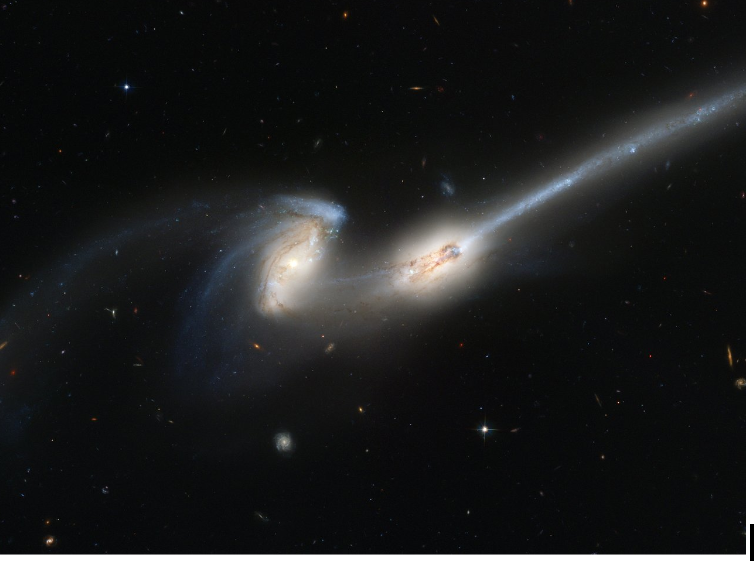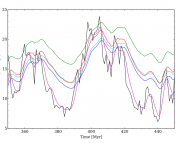Title: Constraining the assembly time of the stellar haloes of nearby Milky Way-mass galaxies through AGB populations
Authors: Benjamin Harmsen, Eric F Bell, Richard D’Souza, Antonela Monachesi, Roelof S de Jong, Adam Smercina, In Sung Jang, Benne W Holwerda
First Author’s Institution: University of Michigan Department of Astronomy
Status: Published in MNRAS [closed access]
Watching a galaxy evolve in real time is impossible because astronomers cannot observe it over the necessary timescales where significant changes take place– which is usually at least hundreds of millions of years! However, there are some methods we can use to try to reconstruct what happened to a galaxy before how we see it today. In particular, this paper tackles how we can understand the effects of galaxy mergers and the accretions of smaller galaxies onto a more massive galaxy. Mergers and accretions are vital parts of how a galaxy comes to be: through matching simulations to observations, we know that mergers can thicken or destroy the disks of galaxies, trigger star formation, and give a galaxy its satellite galaxies, which are smaller galaxies that orbit a more massive galaxy (the Milky Way’s largest satellite galaxy is the Large Magellanic Cloud). Figure 1 shows an example of two galaxies in the process of merging.

One particular place to look for clues of a recent galaxy merger is in the galaxy’s stellar halo, which is the very outermost region of a galaxy. Stellar haloes are the accumulated debris from other galaxies merging into the outskirts of a galaxy; therefore, most of the stars in a galaxy’s halo were originally born in other galaxies that had merged with the main galaxy. Therefore, stellar halos offer a window into galaxy mergers and accretions and their effects on the galaxy’s evolution.
We can probe when two galaxies merged by studying the star formation history (a measure of stellar mass formed as a function of time during the galaxy’s lifetime) of the main galaxy’s halo. There is a clear observational signature due to the accretion of a galaxy in the star formation history. This is because when a galaxy accretes a satellite, ram pressure stripping (gas loss due to the interaction of the main galaxy’s circumgalactic medium, the gas enclosing each galaxy) causes star formation to shut down in the accreted satellite. Therefore, the time of star formation shutoff in a satellite galaxy is a useful probe for when the galaxy accreted.
The most robust way to probe a galaxy’s star formation history is via its resolved stellar populations. In short, we can reconstruct observed stars’ luminosities and colors by matching models to observations. For example, if we see an abundance of red clump stars at a certain color and luminosity, we can reconstruct when those stars formed because we understand their evolution. Normally, the best stars for reconstructing star formation histories are red clump stars and Main Sequence Turn-off stars (MSTO). However, the kinds of deep photometric measurements necessary to resolve red clump and MSTO stars to age-date stellar halos are only available in nearby galaxies in our Local Group, which spans out to only about 2 Mpc from us.

This paper proposes a new method for probing star formation histories by instead using asymptotic giant branch (AGB) stars and red giant branch (RGB) stars. AGB stars are intermediate mass (1-8 M☉) evolved stars, and RGB stars are less massive (<2 M☉) ancient stars. Because RGB stars have much larger lifetimes than AGB stars, the ratio of AGB/RGB stars in a given galaxy is a crude measure of age, where a larger AGB/RGB ratio indicates a younger age. For example, in Figure 2, the youngest galaxy Fornax has many AGB stars, whereas the oldest galaxy And I has the fewest AGB stars.
This paper in particular for the first time uses the AGB/RGB ratio as an approximate measure of when the star formation history shuts off in a halo. First, the authors calibrated the relationship between AGB/RGB ratio and t90, the time at which 90% of the stellar mass in a galaxy formed. The authors chose to use t90 because since AGB stars are at least 300 Myr, AGB stars will be insensitive to star formation histories within the last 300 Myr. They used archival data for galaxies that had already had their SFHs measured using the red clump/MSTO method. Indeed, the authors found a significant (albeit with large scatter) relationship between the t90 parameter and AGB/RGB ratio, which is shown in Figure 3 as the black points.

After calibrating this method with the archival data, the authors used the relationship (shown in Figure 3 as the red line) to measure t90 of three galaxies with masses similar to the Milky Way: M81, NGC 253, and NGC 891, from Hubble Space Telescope imaging. They found that NGC 253 and NGC 891 had prominent numbers of AGB stars whereas M81 had fewer AGB stars, indicating M81 had a larger t90 and therefore formed most of its mass earlier than NGC 253 and NGC 891.
From these results, the authors found a tentative relationship between halo age and stellar halo mass in these galaxies— where galaxies (with similar masses to the Milky Way) with larger stellar halos tend to assemble more recently. The authors plan to extend this study to more galaxies to further test this method. Furthermore, the models of AGB stars are still relatively uncertain; better theoretical understanding of the AGB stars’ evolution will also improve this work.
Astrobite edited by Karthik Yadavalli
Featured image credit: Hubble Space Telescope and Microsoft, Adapted by Abby Lee




